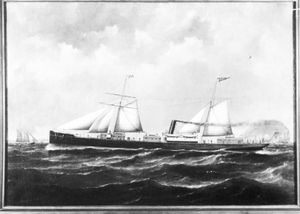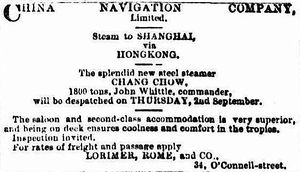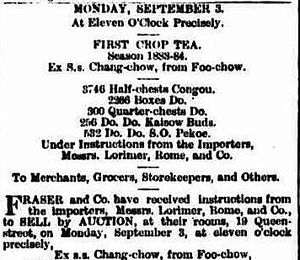Changchow I
Sister ship of Whampoa, Woosung I and Taiwan I
Contents
- 1 History
- 2 Service
- 2.1 Brisbane Courier Mail 21st August 1883
- 2.2 Brisbane Courier Mail 22nd August 1883
- 2.3 Brisbane Courier Mail 24th August 1883
- 2.4 Sydney Morning Herald 25th August 1883
- 2.5 27th August 1883
- 2.6 The Argus 31st August 1883
- 2.7 The Argus 4th September 1883
- 2.8 The Argus 5th September 1883
- 2.9 Sydney Morning Herald 8th September 1883
- 2.10 Sydney Morning Herald 14th September 1883
- 3 Events / Stories
- 4 Images
History
Service
Built for China Coast trade.
Brisbane Courier Mail 21st August 1883
“The steamer Ocean and The China S.N. Company's steamer Chang Chow, from Hong- kong, both arrived off Cape Moreton yesterday morning. The former has on board ninty-nine Chinese passengers and 250 tons of general cargo for this port, and the latter has a number of Chinese, probably 100, and a quantity of mixed cargo for Brisbane,. The Ocean after receiving a pilot left for the Bay, and probably reached the roadstead, where the Francis Cadell awaits her early this afternoon. The Chang Chow at the time of our going to press was hove-to inside the Cape awaiting for a pilot.”
Brisbane Courier Mail 22nd August 1883
“Chang Chow, China S.N. Company's s., from Hongkong for Sydney and Melbourne, anchored in the Brisbane roadstead on Monday night. Of the Chinese passengers on board only thirty-three are for Brisbane, and there is no cargo for this port. The steamer President left early yesterday evening to bring the Chinese to town, and the Chang Chow probably resumed her voyage during the night”.
Brisbane Courier Mail 24th August 1883
“Chang Chow, China S.N. Company's s., .which left the Brisbane roadstead on Tuesday night for Sydney and Melbourne; returned to port yesterday morning for a fresh supply of coals, entered the river at 11.40 am and made fast to a buoy opposite Messrs. Parbury, Lamb, and Raffs wharf early in the afternoon. She will probably resume her voyage this morning.”
Sydney Morning Herald 25th August 1883
“The steamship Changchow is the third of the China Steam Navigation Company’s steamers to visit this port. She is a sister ship to the Whampoa and the brightness and scrupulous order which were conspicuous in Captain William’s ship are equally noticeable in the Changchow. Captain Whittle who was here last in the Tamsui has command of the Changchow and he reports that she left Hong Kong on the 1st instant and had fine weather and the usual trades till the 14th. Strong SE winds succeeded and continued until Changchow arrived at Brisbane on the 20th. After landing 33 Chinese and a quantity of cargo she left Moreton Bay at 7.30am on the 22nd but immediately afterwards fell in with a heavy SSW gale and in consequence of there being not enough coal in the bunkers to carry her through such weather Captain Whittle put back to Brisbane and obtained a further supply. A fresh departure was taken at 11.30 am on the 24th and NE and variable winds and fine weather prevailed till arrival. The Heads were entered at 9.15am and after being processed by the Health Officer the Changchow steamed up to berth at Struth’s Wharf. She has about 1280 tons of tea for Sydney and Melbourne.
Imports;
Sydney; Tea.12835 boxes ; 6472 half chests ; 3311 pkgs. 3 c/s silk; 4 c/s sewing machines; 378 packages.
Wellington 235 pks tea
Lyttelton 650 pkgs tea
Dunedin 1602 pkgs tea
Melbourne; 36819 pkgs tea; 100 bamboo ladders
Adelaide; 1639 pkgs tea.
27th August 1883
Changchow departed Sydney for Melbourne.
The Argus 31st August 1883
Arrived. Chang Chow, s s , 1734 tons John Whittle, from Foochow 28th ult, Hong Kong 1st inst, Brisbane 24th inst, and Sydney 28th inst. Passengers from Hong Kong for Melbourne Captain Mackay, Mr Carnie, Mr Lord, and 11 Chinese in the steerage. Lorimer, Rome, and Co , agents. Imports. Chang Chow, from Foochow and Hong Kong - 19547 hlf- chts, 16 217 bxs 47 pkg,s tea; 240 pkgs white rice, 70 bls matting, 100 bamboo ladders, 1427 pkgs chow chow cargo for Melbourne;, also, 75 cs ginger, 50 chts 751 hlf-chts, 754 bxs tea, 80 cs chow chow - cargo in transit for Adelaide; and 529 hlf chts, 1,518 bxs tea for New Zealand. Included in the manifest of the above is the following consignment - 1402 pkgs tea – Lawrence and Adam.
THE SS CHANGCHOW.
This vessel is the second of the steel screw steamers which have been set apart by the China Navigation Co and Messrs Swire and Co, of London, for trading between China and these colonies. The first to arrive here was the Whampoa. She was thought a good deal of for her appearance and equipment and she was considered moreover, a very fitting boat for the purpose for which she was intended. The Changchow is such another boat as the Whampoa. She was laid down on the same lines, her dimensions are the same, the accommodations are similarly planned out and she was launched from the same yard - Scott and Co’s Greenock – as the Whampoa. The engines are also from the same establishment and if there are any differences between these steamers it is that the Chang Chow has slightly the advantage in horse power. The thorough cleanliness and order in which these boats are kept is something surprising and the crew of Mongolians on hoard are as clean and tidy in appearance as their vessel.
The Chang Chow was despatched to Foochow for a cargo of the present season’s tea, and on her way down she called at Hong Kong for passengers and some chow chow freight. The steamer is commanded by Captain J Whittle who was. last here in the company’s steamer Tamsui. The cargo of this boat it will be recollected was all discharged by hand, and without the aid of slings or winches. The packages were handed from stage to stage until deposited in the customs shed. The Captain reports that the Chang Chow, after taking in her complement of tea left Foochow on the 28th ult , and called at Hong Kong, whence she sailed on the 1st inst, and had light winds and fine weather until the 14th inst. The trades then increased in force, and blew hard for several days, and this added in some measure to the length of the passage. Moreton Bay was reached on the 19th inst, and the inner roads on the following day. A quantity of cargo and a number of Chinese passengers were landed and the voyage was resumed on the 22nd at half past 7 am. A hard gale then set in from the SSW, and in the face of prospective heavy weather Captain Whittle returned and went up the river to Brisbane to secure a supply of coal to carry the steamer to Sydney. The Chang Chow finally left Brisbane at half past 11 am, on the 24th, and had variable winds, mostly from the NE until arrival at Sydney at quarter past 9 am on the 26 th inst. After the discharge of the Sydney portion of the cargo, the Chang chow left on the morning of the 28th inst and had moderate winds and fine weather on the passage along the coast. The Heads were entered 20 minutes after noon, and the steamer then went into quarantine. She was released at a quarter to 2 pm when she started for Hobsons Bay by way of the West Channel. On being cleared inwards by the customs she was taken in tow by the steamer Pharos and proceeded up the river to the wharf where her tea and other cargo will be discharged. The steamer will have quick despatch and it is expected that her cargo will be all out by tomorrow night or Monday morning.
The Argus 4th September 1883
The landing of the large cargo of tea brought here from Foo-chow by the steamship Chang-chow has been going on steadily since her arrival, and the last of it will be out today. The same method of discharging cargo as was adopted on board the steam- ship Tam-sui last season has been made use of on the Chang-chow. The packages are all man-handled, and passed from stage to stage until they are sent over side into the Customs shed at the south wharf, where the tea is being stored until its removal. As the packages become reduced in number in the 'tween decks and lower hold the stages are adjusted, and the boxes are still passed up and out from hand to hand with wonderful rapidity. This fashion of discharging and loading a tea cargo is greatly in vogue in China, as the packages are less liable to be marked by the slings. The cargo by the Chang-chow has been landed in unexceptionable order, the packages being as clean and intact as if fresh from the warehouse. When the unloading has been completed the steamer will return to China. The Tai-Wan is the next boat of the China Navigation Company expected here.
The Argus 5th September 1883
Cleared outwards; Changchow, 1,100 tons, John Whittle, for Shanghai via Sydney. Lorrimer Rome & Co agents.
Sydney Morning Herald 8th September 1883
Arrivals. Changchow from Melbourne.
Sydney Morning Herald 14th September 1883
Departures. Changchow for Shanghai with 1700 tons coal, 119 bdls old copper and 27 Chinese passengers.
Sydney 14th September 1883. Changchow departs for Shanghai.
Events / Stories
The Loss of Changchow
A file of unremarkable press clippings are all that remain to tell the tale of the last voyage of Changchow in 1884 – a voyage that was in many respects an unusual one.
Changchow was at this time just two years old - the product of an energetic newbuilding programme for China Navigation’s rapidly expanding China coast trade. In 1883, less than a year after delivery, she was switched to the company’s new liner service to Australia - a trade which also employed her sister ship Taiwan, as well as the three-year-old (and somewhat smaller) Keelung, supplemented in the all-important tea season by Keelung’s two sisters, Hoihow I and Tamsui.
It was China tea that brought Changchow on her first, and last, voyage to New Zealand - an area that was very new to CNCo. Hoihow had pioneered the company’s first trans-Tasman crossing in 1883, and Changchow was only the third CNCo visitor. She was therefore regarded as something of an exotic migrant to these southerly waters: a “Flowery Land Trader”, said the Lyttleton Times of 5th October 1884, alluding to her China coast origins. The ship had left Foochow (Fuzhou) bound for Australia on 10th August, calling at Hong Kong, Singapore, the Philippines and Batavia (Java), and reaching Sydney on the 29th August and Melbourne on 2nd September. In addition to Foochow tea, her principal cargo was sugar. Raw sugar from the Philippines and (a landmark for Swire) refined Tai Koo Sugar produced by their newly opened refinery in Hong Kong - the very first consignment to reach the antipodes. The ship also carried an assortment of “Chinese goods”: ginger, spices and silk. It was in Melbourne, however, that Changchow embarked her most exotic cargo, becoming the first CNCo ship to list a live elephant on her cargo manifest. And not just an elephant: an entire circus, complete with acrobats and menagerie!
Chiarini’s Royal Italian Circus – Circo Chiarini - was, at that time, probably the most famous circus in the world. A descendant of one of the most ancient dynasties of the popular show, (the Chiarini name first appeared in connection with Italian popular theatre in the 1580s), the famous equestrian Giuseppe Chiarini (1823-1897) took Circo Chiarini to a global audience. While Barnum & Bailey, Ringling, Sells Brothers and the rest were still touring Europe and America, Chiarini’s company of cavallorizzi (horseback riders), funamboli (tightrope walkers) and his famous performing animals blazed the circus trail in Asia and the Pacific.
In 1853, Chiarini left Europe for Cuba, establishing the first circus in Havana. In 1855, he crossed the Pacific to Japan – where his troupe was one of the first foreign companies of any kind to perform during the late Edo period. On this and subsequent visits Chiarini had a lasting influence on the development of circus in Japan.
In 1864, Chiarini arrived in Mexico in the train of the newly crowned Emperor Maximilian. He remained there during the period of the “French Intervention”, also touring Chile and Argentina. After the defeat of Maximilian’s troops in 1867, however, Chiarini prudently switched allegiance to the victorious Benito Juárez. Marrying political expediency with thriftiness, he chose to lampoon the ousted dictatorship by outfitting his ringside attendants in now-redundant (and cheap) Imperial uniforms. The move greatly boosted his popularity, though inevitably the trademark orange jackets of Chiarini’s band led to the nickname “The Carrots”. In 1869, he returned briefly to Europe, before embarking on a series of ever more ambitious world tours to Brazil, South Africa, India, China, Singapore, Siam (Thailand), Java, Australia and New Zealand.
In September 1884, when the flamboyant Signor Chiarini’s three-ring circus arrived in Auckland via Changchow, the show was making its third visit to the antipodes, having previously toured in 1872 and 1879 to great acclaim. The week-long voyage had been far from pleasant, however: leaving Melbourne on 10th September, Changchow immediately ran into a gale off Port Phillip Heads. The circus wagons housing the menagerie threatened to break loose, and one can but imagine Chiarini’s anxiety for his precious horses, stabled on deck. The captain had no choice but to return to port until the storm abated. Bad weather continued to dog the trip, and it was no doubt a sorry band of performers who disembarked at Auckland on 17th September. But “the show must go on”, and within two days of arrival, as Changchow set sail for Wellington, the tents were erected and the New Zealand Herald reported that “Expectation [was] on tiptoe in anticipation of the opening of Chiarini's Royal Italian Circus.” As a measure of Chiarini’s fame, is interesting to note that the circus anticipated an audience of up to 5,000 for each performance: at the time, this represented more than a quarter of the entire population of metropolitan Auckland.
For Changchow, however the story has a less happy ending. From Wellington, the vessel continued south to Port Chalmers (Dunedin), and then retraced her steps north to Lyttleton (Christchurch). Here, she took on a general cargo that included butter, cheese, and honey, an enormous quantity of potatoes, carrots, peas and beans, wheat, oats and bran, as well as “fungus” (presumably for use in Chinese medicine), scrap iron and zinc, and ten horses for Australia. On 10th October, she began her return voyage to Hong Kong, via Sydney, Newcastle (where she bunkered) and Brisbane. But on 20th October, disaster struck: for reasons we do not know, Changchow went aground in good weather on a spit off Fraser Island, near the Sandy Cape lighthouse. Though the ship was briefly re-floated and beached, she proved to be beyond salvage and was eventually declared a total loss. Six passengers were drowned when one of the ship’s boats taking them ashore capsized.
The loss of Changchow had some far-reaching consequences for China Navigation. Just 11 days earlier, Keelung had also been lost off the China coast. The company abandoned its trans-Tasman ambitions, and not long after Changchow’s fateful visit, CNCo came to an agreement with the New Zealand Steam Ship Company to handle through-cargo from Australia. CNCo did not again attempt to serve Kiwi ports on a regular basis until after the Second World War. The company also bit the financial bullet and commissioned a wholly new class of four passenger/cargo liners – bigger than any of CNCo’s coasters to date - which would be dedicated to the Australian service. Thus came into being the famous Scott’s-built Changsha I class of 1886.




